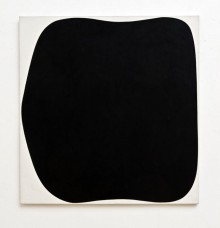Mary Weatherford
black painting 2017

Reproduction of this image, including downloading, is prohibited.
Audio Description (02:38)
Full Audio Transcript (Expand)
black painting
Mary Weatherford’s abstract contemporary black painting from 2017 has stuck an exceptionally bright, thin noodle of a blue neon tube light right down the painting. The light is affixed with tiny metal brackets directly onto the linen canvas, a little left of center. Unlike the straight, rigid tubes normally used in business signs and decorations, this subtly wavering tube is hung just a little bit crooked. The painting is nearly ten feet tall and just over eight and a half feet across. The canvas is stretched over a frame one and three quarters inches deep, which allows the painting to hover in front of the wall it is hung on and cast a shadow beneath itself. This shadow is an echo of the soft glow of lush blue light that spreads out left and right a couple of inches from the tube.
While a glowing neon light is remarkable to find attached to a fairly dark and somber painting, Weatherford equally calls the viewer’s attention to its power source, making no attempt to create an illusion with the light. Two thin black cables connect to the tube light, one to the top and one to the bottom, and they stream down to the floor, bend, and snake a couple of feet along the baseboard to a small white metal box that powers the light.
For the painting, Weatherford used creamy flashe vinyl paint, which dries without leaving brush marks. Black is the dominant color. The longer one explores the painting, the more other colors make their presence known: a short line of royal blue at the same tilt as the neon light, dots and blobs of bright lemon yellow, wide hunks of brown, and bands and globs of peachy orange. Nearly all of the canvas is coated with layers of black over black, black over the other colors, and occasionally the other colors showing over black. The right bottom corner has only splashy dots of orange, black, and yellow, and the right and top edges have hints of canvas showing through. Some of the layers are very thick. In places, the paint is streaked like it was thinned out before being set on the canvas, making it streaky and uneven and allowing the cross hatched texture of the linen to show through. The bottom left corner is cloudy and pale, the black paint having been heavily diluted so that it becomes a wash of gray. Although brush strokes are not apparent and there are very few drips, many of the wide ribbons of color have splatters at their ends. It feels like the artist had shaken the tool with which she had added the paint, bringing a sense of energy and turbulence to its creation.
Redefining Feminism in Modern Art
Is black painting really black? The overwhelming hues of Flashe paint allow Weatherford to layer infinitely, preventing the viewer from distinguishing the color of a certain hue even with sustained looking. The neon strip cuts the work into two, making it almost impossible to imagine the painting without it.
Black painting is a part of Weatherford’s series like the land loves the sea which responds to current events. Charged with a sense of place and distinct Americanness following the 2016 election, it’s as if Weatherford is still painting and adding hues through the viewer’s gaze, deconstructing the turbulence of American politics and social fabric. Influenced by the sheer amount of neon signs in Los Angeles, the strip of neon light contrasts the somberness of the painting’s hues, forcing the viewer to confront the duality of vision and recognition and playing on American numbness to turbulence.
—Irmak Ersoz ‘24







